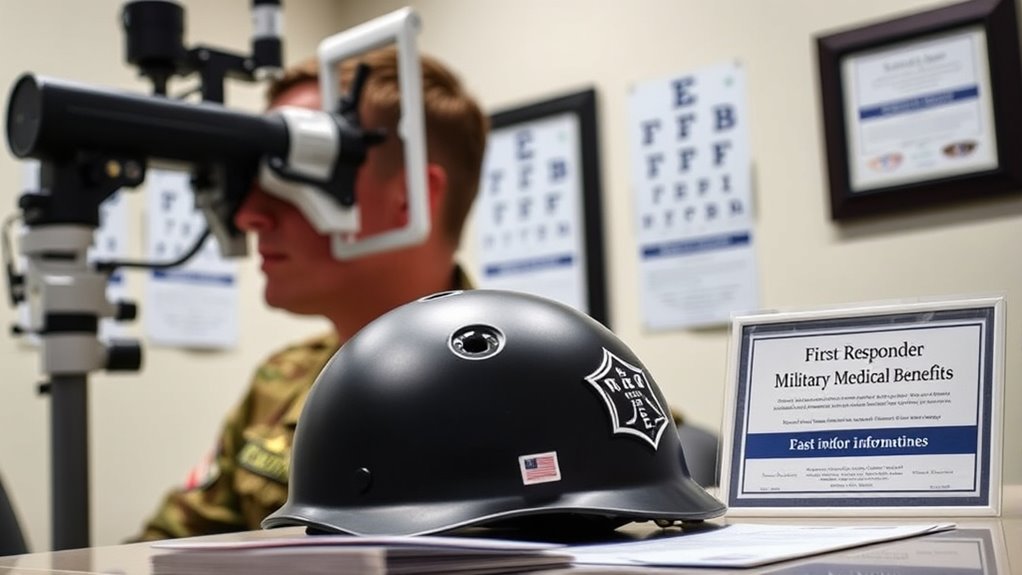Most insurance plans don't cover LASIK since it's considered an elective procedure, not a medical necessity. You'll typically pay out-of-pocket ($2,000-$3,300 per eye), though vision insurance may offer discounts ranging from 15-50%. In rare cases, LASIK might be covered if deemed medically necessary for conditions like severe refractive errors or anisometropia. HSAs and FSAs can help manage costs with pre-tax dollars. Investigate financing options to enhance your savings while maintaining healthy vision.
The Standard Insurance Stance on LASIK Surgery

While LASIK surgery has revolutionized vision correction for millions of patients, most standard health insurance plans classify it as an elective or cosmetic procedure, placing it outside the scope of covered services.
Insurers prioritize treatments addressing health threats over vision correction, with Medicare explicitly excluding LASIK entirely.
One common LASIK myth is that vision insurance automatically covers the procedure. In reality, plans like VSP or EyeMed typically offer only modest discounts (10-25%) rather than extensive coverage. The LASIK Vision Institute often matches these discounts for patients who inquire about insurance benefits.
Providers consider LASIK "optional" because LASIK alternatives like glasses and contacts exist, further justifying coverage denials. Even private insurers like Blue Cross and Aetna generally reject claims but may offer provider-specific discounts instead. Cigna follows a similar approach, not covering LASIK but providing access to discount programs through their partner networks.
This classification means 99% of patients pay out-of-pocket, with costs averaging $2,000-$3,300 per eye. However, LASIK may be covered if it's deemed medically necessary for significant vision problems that impact daily activities.
Rare Cases When Insurance Might Cover LASIK
Despite the general exclusion of LASIK from insurance coverage, certain exceptional circumstances can qualify the procedure as medically necessary rather than merely elective.
While LASIK is typically not covered by insurance, rare medical necessities can sometimes qualify for coverage.
These rare conditions typically involve documented medical issues where traditional vision correction methods prove inadequate or harmful. Conditions like anisometropia, where there's a significant difference in prescription between eyes, may qualify as medical necessity under some insurance plans.
In unique situations, your insurance might provide coverage when:
- You have severe refractive errors or corneal abnormalities that can't be corrected with glasses or contacts
- You work in specific occupations with vision requirements (military, primary responders, safety-critical roles)
- You've experienced eye trauma or injury resulting in vision impairment
- Your employer offers specialized vision plans with LASIK benefits
To pursue coverage, you'll need thorough documentation, pre-authorization from your insurer, and ophthalmologist reports confirming that non-surgical treatments have failed to address your condition. Some specialty unions or self-insured employers may allocate funds specifically for LASIK procedures for their members or employees. Additionally, individuals with severe dry eye or contact lens intolerance might have greater chances of insurance approval when these conditions significantly impact daily functioning.
Understanding Vision Insurance Discount Programs

Although traditional insurance rarely covers LASIK surgery, many vision plans offer substantial discount programs that can greatly reduce your out-of-pocket costs.
These programs provide 15-50% savings through different structures, including standalone plans, insurer partnerships, and employer-sponsored options.
Major providers like Aetna, VSP, and Blue Cross Blue Shield offer tiered discounts through networks such as QualSight, with procedures ranging from $945-$1,795 per eye. EyeBenefits Discount Vision Program is another option that provides 40% to 50% savings on LASIK procedures at over 2,000 centers nationwide. MHBP members can access Vision discount program options that include savings of $800 on LASIK surgery through LasikPlus. LasikPlus maintains relationships with nearly all major insurance companies to provide competitive pricing for their members.
Your discount eligibility typically requires using in-network providers and can't be combined with other promotions.
Maximize your savings strategies by using HSA/FSA funds (reducing costs by 20-30%), bundling services, and comparing insurer-specific rates.
Many programs activate immediately upon enrollment with no waiting periods, allowing you to access LASIK discounts right away.
How to Check Your Insurance Plan for LASIK Benefits
Determining whether your insurance offers any LASIK benefits requires systematic investigation through multiple channels.
Begin by thoroughly examining your policy documents for specific terms like "refractive surgery," "vision correction," or references to alternative procedures such as vision therapy. Most insurers classify LASIK as elective but may offer partial coverage under specific circumstances.
- Review your policy's exclusions section to identify explicit limitations for vision correction procedures.
- Contact your provider directly to inquire about pre-authorization requirements and network-specific discounts.
- Consult your employer's HR department regarding supplemental vision plans or negotiated provider discounts.
- Verify FSA/HSA eligibility to utilize pre-tax funds for LASIK expenses.
Even in cases where full coverage is denied, some vision insurance plans provide partial discounts for LASIK when performed by participating providers in their network. Higher discounts of up to 50% are often available when choosing in-network surgeons for your procedure.
For thorough verification, obtain written confirmation of any coverage details from your insurer to prevent post-procedure billing disputes.
Many vision insurance companies, including EyeMed and VSP, offer specific LASIK discounts worth investigating as an alternative to medical insurance coverage.
Military and First Responder Special Coverage Options

Military personnel and initial responders have access to specialized LASIK coverage options that aren't typically available to civilians. The Department of Defense operates 26 military laser centers providing no-cost procedures to active-duty members through the Warfighter Refractive Eye Surgery Program, though military eligibility requirements include command approval and service commitments of 12-24 months post-surgery. These programs exist because eyewear presents hazards in military operations including risk of losing glasses during combat. Visual acuity impacts overall safety and mission success in combat environments. Most providers offer transparent pricing with no hidden fees, making it easier for service members to understand their benefits.
While TRICARE classifies LASIK as elective, numerous private providers offer substantial discounts. Initial responder partnerships include programs like LasikPlus's 20% discount for police, firefighters, and EMTs, while the First Responders Benefit Trust caps costs at $1,800 per eye.
These benefits often extend to spouses as well. Employment verification is required to access these specialized rates, and aviation or tactical positions typically mandate 3-6 months of vision stabilization before returning to duty.
Using HSAs and FSAs to Pay for LASIK
While most insurance plans don't cover LASIK surgery, you can still use tax-advantaged accounts to reduce your total costs considerably. Both Health Savings Accounts (HSAs) and Flexible Spending Accounts (FSAs) classify LASIK as an eligible expense, offering significant tax advantages when funding your procedure.
- HSA benefits: Funds roll over indefinitely, with 2024 contribution limits of $3,850 for individuals and $7,750 for families.
- FSA limitations: "Use-it-or-lose-it" policy applies, with a 2024 contribution limit of $3,200. The FSA contribution limit will increase to $3,300 in 2025.
- Tax advantages: Using pre-tax dollars can save 20-30% on LASIK costs depending on your tax bracket.
- Contribution strategies: Consider coordinating surgery timing with contribution cycles, potentially using a limited-purpose FSA alongside your HSA for vision expenses. Premium LASIK providers can facilitate HSA or FSA payments with minimal paperwork and administrative hassle.
Always verify your eligibility for LASIK before funding these accounts, as not everyone qualifies for the procedure. When confirming coverage details, have your insurance card ready with your group code and policy number to expedite the verification process.
Medical Necessity Documentation Requirements

To secure insurance coverage for LASIK, you'll need your ophthalmologist to complete a physician certification process documenting functional impairment, failed conservative treatments, and qualifying corneal measurements.
Your pre-authorization appeal steps require submission of detailed vision tests, refractive stability data, and medical history with clear evidence linking LASIK to resolving specific functional limitations.
Insurance companies often mandate specific forms, diagnostic imaging results, and signed physician attestations that explicitly connect your vision condition to medical necessity criteria rather than cosmetic preference. Most insurers consider the presence of severe refractive errors not correctable with standard eyewear as a qualifying criterion for LASIK coverage.
Physician Certification Process
Securing insurance coverage for LASIK requires physicians to navigate a rigorous certification process that documents clear medical necessity. Your ophthalmologist must provide thorough clinical evidence that demonstrates your LASIK isn't merely cosmetic but medically required.
Physician assessments must include detailed measurements of your refractive error and documentation of functional impairments. Insurance providers broadly categorize LASIK as elective surgery and rarely offer coverage without substantial evidence.
The certification requirements typically involve:
- A signed letter of medical necessity from a licensed ophthalmologist detailing your specific diagnosis
- Documentation of stable refraction over at least 12 consecutive months
- Corneal topography and pachymetry results confirming your eligibility
- Evidence of failed non-surgical interventions, including specialized contact lens trials
These medical records must establish that your condition exceeds standard thresholds (typically ±8.00 diopters) or demonstrate your documented inability to tolerate corrective devices due to physical limitations.
Pre-Authorization Appeal Steps
Once your ophthalmologist completes the certification process, you'll likely need to navigate the pre-authorization appeal steps if your initial request for LASIK coverage is denied. Understanding effective appeal strategies is vital for reversing unfavorable decisions.
| Appeal Action | Pre-Authorization Tips |
|---|---|
| Request denial rationale | Contact insurer specifically for denial reason (coding errors vs. missing criteria) |
| Gather evidence | Collect thorough medical records, peer-reviewed guidelines, prior approvals |
| Submit appeal letter | Include clinical rationale with proper ICD-10 codes and supporting documentation |
| Adhere to timelines | File within 30-180 days; request expedited review for urgent cases |
| Escalate if necessary | Proceed to external review with state/CMS-appointed reviewers after internal appeals |
Documentation requirements include thorough medical records, diagnostic test results, treatment history, specialist letters, and relevant clinical studies aligning with your specific condition.
Major Insurance Providers' LASIK Policies
Major health insurance providers typically don't cover LASIK but offer discount programs through affiliated vision plans.
Blue Cross Blue Shield partners with QualSight for 40-50% savings off national averages, while Anthem Blue View Vision plans provide up to $800 in discounts.
Aetna offers more modest benefits with 15% off retail prices through contracted providers and 5% discounts on promotional pricing, whereas UnitedHealthcare vision plans include different LASIK discount options for members.
Blue Cross Blue Shield
How does Blue Cross Blue Shield approach LASIK coverage? BCBS generally classifies LASIK as an elective procedure, with coverage varying greatly based on your specific plan type, employer negotiations, and geographic location.
Medical necessity LASIK exceptions exist when documented conditions prevent safe use of glasses or contacts.
Most BCBS members access discounts rather than full coverage through partnerships with providers like QualSight:
- Federal Employee Program (FEP) Vision offers 15-50% discounts through QualSight's network
- Anthem BCBS provides up to $1,000 off procedures via Leading LASIK Network
- CareFirst BCBS offers 30% discounts, potentially reducing costs from $2,500 to $1,700 per eye
- Out-of-network providers typically receive no coverage benefits
Verify your specific benefits by contacting BCBS customer service with CPT code S0800, or investigate alternative payment options like HSAs and FSAs.
Aetna LASIK Discounts
Unlike traditional vision benefits, Aetna follows the industry standard by classifying LASIK as an elective procedure, offering discounts rather than direct coverage.
As an Aetna member, you'll receive approximately 15% off retail pricing through participating providers in their Vision Discount Program, potentially saving $750-$1,500 on bilateral procedures.
To access Aetna discounts, verify your LASIK eligibility through their EyeDocLocator tool or by calling 1-800-793-8616.
You'll need your member ID when scheduling consultations at affiliated centers. Bear in mind these discounts can't be combined with other insurance plans but work effectively with FSA/HSA accounts for further tax advantages.
In rare cases involving severe corneal damage or when performed alongside cataract surgery, Aetna may provide partial coverage under medical necessity provisions.
UnitedHealthcare Vision Plans
UnitedHealthcare follows the industry standard by classifying LASIK as an elective procedure, offering significant discounts rather than direct coverage through their vision plans. Your LASIK eligibility depends on enrollment in employer-sponsored group plans, with savings of 20%-35% compared to national averages when using in-network providers like QualSight.
UnitedHealthcare benefits for LASIK include:
- Contracted rates of $945/eye for Traditional LASIK and $1,395/eye for Custom LASIK
- Access to 800+ accredited surgeons nationwide
- Lifetime improvement guarantees at no extra cost
- Compatibility with HSA/FSA funds for pre-tax payment options
To verify your benefits, contact UHC's Laser Vision program at 1-855-321-2020 and provide your member ID during consultation with participating providers.
Comparing Insurance Discounts vs. Provider Financing
When maneuvering the financial aspects of LASIK surgery, patients typically face two primary options: leveraging insurance discounts or utilizing provider financing programs. Insurance negotiation strategies can reduce costs by 15-50%, with vision-specific insurers offering up to $1,500 discounts per eye through network surgeons.
| Option | Cost Reduction | Key Considerations |
|---|---|---|
| Insurance Discounts | $1,295-$1,895 per eye | Requires network restrictions |
| Provider Financing | $0 down, ~$183/month | 0% interest for 12-24 months |
| HSA/FSA | Pre-tax payment | Requires health plan enrollment |
When comparing financing alternatives, consider that insurance discounts offer greater long-term savings but limit provider selection, while financing plans provide flexibility but risk deferred interest penalties. Combining strategies—such as using FSA funds with insurance discounts—maximizes savings while maintaining cash flow.
The Long-Term Financial Benefits of LASIK vs. Insurance

While LASIK typically requires a significant upfront investment, you'll likely recoup these costs through the elimination of recurring vision expenses over time.
Your lifetime savings can range from $10,000-$27,300 compared to continuing with glasses or contacts for 20+ years.
You can further enhance your financial benefits by utilizing tax-advantaged payment options like FSAs or HSAs, which effectively reduce LASIK costs by 20-30% through pre-tax contributions.
SUBHEADING DISCUSSION POINTS
Many patients considering LASIK focus primarily on its upfront costs without recognizing the substantial long-term financial advantages. While you'll initially invest $4,400 on average, this one-time expense is offset by eliminating recurring eyewear costs that total $11,000-$27,300 over your lifetime.
Common LASIK myths suggest the procedure isn't financially viable, but patient testimonials consistently report financial benefits beyond improved vision:
- Annual savings of $500-$3,000 on glasses, contacts, and solutions
- Break-even point typically reached within 2-5 years post-surgery
- HSA/FSA pre-tax payments reduce effective costs by 20-30%
- Productivity increases of 25% from eliminating eyewear maintenance (60+ hours/year)
The cost-benefit analysis becomes even more favorable when considering career advancement opportunities in vision-dependent fields and reduced expenses for specialized eyewear.
Lifetime Vision Cost Analysis
The financial calculus of LASIK surgery extends far beyond its initial price tag when compared to traditional vision correction methods. While you'll invest $4,000-$6,600 upfront, this one-time expense typically breaks even within 4-7 years against recurring eyewear costs.
| Expense Category | LASIK | Glasses/Contacts |
|---|---|---|
| Initial Cost | $4,000-$6,600 | $300-$800 |
| Annual Maintenance | $0 | $1,200-$3,000 |
| 10-Year Total | $4,000-$6,600 | $12,000-$30,000 |
| 20-Year Total | $4,000-$6,600 | $24,000-$60,000 |
| Lifetime Savings | $22,300-$49,825 | $0 |
Your eyewear comparison should account for specialized needs like prescription sunglasses and sports goggles, which add $113-$600 annually. Post-LASIK, you'll also save $180-$420 yearly by reducing vision insurance premiums—further enhancing your lifetime savings.
Tax-Advantaged Financing Options
Though LASIK offers compelling long-term financial advantages, smart financing can further enhance these savings. Tax-advantaged payment strategies provide significant opportunities to reduce your effective LASIK cost through pre-tax funds.
Health Savings Accounts (HSAs) and Flexible Spending Accounts (FSAs) deliver substantial tax savings when allocated for LASIK expenses:
- HSAs offer triple tax advantages: pre-tax contributions, tax-free growth, and tax-free withdrawals for qualified procedures.
- FSAs allow up to $3,200 (2025) in pre-tax contributions annually for LASIK.
- Combined HSA/FSA utilization optimizes available tax benefits.
- Pre-tax payment typically reduces effective LASIK costs by 20-30%.
Additionally, you may qualify to itemize LASIK as a medical expense deduction if your total medical expenses exceed 7.5% of your adjusted gross income.
Frequently Asked Questions
Does LASIK Affect Future Insurance Premium Rates?
LASIK won't affect your health insurance premiums since it's classified as elective.
Your vision plan might reduce discounts for glasses/contacts post-procedure, though LASIK financing options often include FSA/HSA benefits without premium impacts.
Life/disability rates remain unchanged unless severe complications develop.
When evaluating LASIK eligibility criteria, insurers focus on pre-existing conditions rather than the procedure itself.
Some vision insurers may reclassify you as "low-risk" afterward, potentially affecting tiered benefits but not increasing premiums.
Can I Use Multiple Insurance Plans for Bigger LASIK Discounts?
You generally can't stack multiple insurance plans for bigger LASIK discounts.
Most providers and plans have specific discount eligibility terms that prohibit combining insurance-based discounts. Insurance plan stacking is explicitly excluded in most policies to prevent double-dipping.
Instead, you'll achieve ideal savings by selecting the highest single discount available to you. Always verify with both your LASIK provider and insurers to confirm which specific discount will enhance your savings.
Are LASIK Touch-Up Procedures Covered Differently Than Initial Surgery?
Yes, LASIK touch-up coverage differs considerably from initial surgery coverage.
While initial LASIK is occasionally discounted by vision plans (15-50%), touch-ups are rarely covered by insurance.
Many clinics offer lifetime assurance plans with free or reduced-cost improvements ($0-$500 versus $1,000-$2,500 per eye).
Provider-based improvement plans typically require adherence to post-op care and exclude mature-related vision changes.
You'll find touch-ups cost 20-50% less than your initial procedure when paying out-of-pocket.
How Do Insurance Policies Handle International LASIK Procedures?
Insurance policies typically don't cover international LASIK procedures due to consistent global classification as elective.
International policy differences mean you'll face similar exclusions worldwide, though Asia-Pacific regions occasionally include LASIK in premium plans.
When considering overseas provider considerations, verify if your insurer recognizes foreign credentials or has network partnerships abroad.
Your best options include using FSAs/HSAs at U.S.-affiliated international clinics or leveraging expatriate health packages that sometimes include LASIK allowances for employees stationed overseas.
Will Insurance Cover LASIK Complications if Surgery Wasn't Covered?
Insurance may cover your LASIK complications even if the original procedure wasn't covered.
Complication coverage typically requires medical necessity documentation from your ophthalmologist. You'll need specific ICD-10 codes for surgery aftermath issues like infections or corneal ectasia.
Your insurer will evaluate functional impairment and require pre-authorization. For ideal claims processing, submit itemized billing that clearly separates complication treatment from the elective procedure.
Alternative funding options include HSAs or specialized surgical complication insurance.

